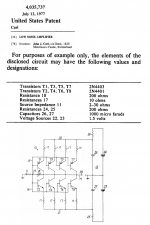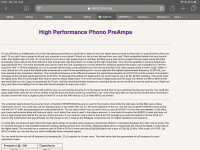This is one of the lesser Leach variants. JC's has a lot more noise & THD than the best ones if running at the same current & gain even if it has zillion parallel pairs of supadupa LN transistors. It uses twice as many batteries for poorer performance all round.What still seems to be missing is the ultra simple MC HA from John Curl.
It had 4 parallel PNP's and NPN's, supplied from two 1.5V batteries.
With modern ZTX transistors only one complementary pair will result in the same performance, see first image below.
You may have an output resistor missing in your first 2 pics.
Got a link to the original? I'd like to see some measurements. The idea is good but implementation is really tricky. You might be better off with my battery version feeding his virtual earth OPA2134.I found this.
If I was having a go, I'd do this first and then see if I can get his floating supply to work without introducing more noise.
I actually did try a somewhat more sophisticated version of his scheme in the 1980s (The virtual earth included the input stage) But could only equal the performance of my battery version with loadsa extra complexity
Last edited:
Maybe you could be so kind to simulate both versions side to side to substantiate your vision.This is one of the lesser Leach variants. JC's has a lot more noise & THD than the best ones if running at the same current & gain even if it has zillion parallel pairs of supadupa LN transistors. It uses twice as many batteries for poorer performance all round.
You may have an output resistor missing in your first 2 pics.
Even the differential version with 3dB noise penalty has only 340nv/rtHz with only one complementary pair per amp running at a very modest 1mA.
With a THD below 100dB and a CMRR of 80dB, it is not exactly my definition of a lot more noise and THD.
Hans
Scott,
Should your 2.25nV per mV be read as 2.25nV/rtHz per mV@5cm/sec@1kHz ?
In that case S/N would be -70dB for a 20kHz BW, assuming that this noise would be flat from 20Hz to 20kHz.
That -70dB number was simply a guess at an absolute best case no weighting, etc. At -60dB optimizing RTI noise at the expense of most other parameters seems not the best exercise. The transformer feedback concept on paper can achieve .06nV be it could be adopted to MC.
Last edited:
Very nice to have all these variations together in one document.
What still seems to be missing is the ultra simple MC HA from John Curl.
It had 4 parallel PNP's and NPN's, supplied from two 1.5V batteries.
With modern ZTX transistors only one complementary pair will result in the same performance, see first image below.
To lower output impedance and distortion quite a bit, a low noise LT6202 can be added.
And finally to almost eliminate current flowing into the Cart, a LT1884 will do a perfect job, the whole circuit still being fed with with three 1.5 volt batteries supplying just 4 mA,
one battery for the negative and two for the positive supply, see second image.
The third image shows a fully differential topology, fed from a phantom power.
The circuit diagram at the right is shown as an OPA in the left part of the image.
Noise RTI after Riaa and A-weight is 48nV, or 0.34nV/rthz equivalent input noise.
Hans
Thanks Hans - they will be duly added to the compendium next week.
What cartridge would you like to use? What recorded velocity?Maybe you could be so kind to simulate both versions side to side to substantiate your vision.
Even the differential version with 3dB noise penalty has only 340nv/rtHz with only one complementary pair per amp running at a very modest 1mA.
With a THD below 100dB and a CMRR of 80dB, it is not exactly my definition of a lot more noise and THD.
Do you prefer his differential version or are you happy with his single ended 'Leach copy'?
We will of course use the very best transistors in our little comparison. Have you got SPICE models for these?
If you have an LTspice circuit of the circuit you would like me to simulate, please post it so there can be no cheating in my comparison
We can do a theoretical noise analysis if you prefer. Guru Wurcer can adjudicate
PS: Is your 340nV/rt(Hz) (??) with RIAA & A wt? Have you built it?
My 280pV/rt(Hz) is measured over 20-20k Hz when I had access to B&K true rms voltmeters & other fancy stuff.
_____________________
Bonsai, have you got SPICE models for ZTX851/951?
Last edited:
Thanks for this Joachim. The actual link isHere is the link. There are other phono circuits too.
High Performance Phono PreAmps
There he says, "[FONT=Arial,Helvetica][SIZE=-1]In the 3 previous circuits the power supplies for the head amps could be replaced with a 9V battery for each channel for extra low noise operation."
I'm not sure he has even tried out these circuits as he presents 3 versions and has no measurements or recommendations.
I think the Solar Cell / Photodiode are a better bet for a supadupa LN floating supply.
At these noise levels, you really need to try things out. The reason I prefer the simple solutions is, with them, real life is more likely to reflect the sims. Guess how I know this
[/SIZE][/FONT]
Last edited:
SE is fine and as long as both topologies are using the same Cart, I don't care about the details.What cartridge would you like to use? What recorded velocity?
Do you prefer his differential version or are you happy with his single ended 'Leach copy'?
We will of course use the very best transistors in our little comparison. Have you got SPICE models for these?
It was your own statement that the JC version had a lot more noise and THD, so it's up to you to.
And yes of course, I have the Spice models for both ZTX models.
And yes measurements with these transistors are within 1 dB with the simulations, see for instance: A Low Noise Balanced Input Moving Coil Preamp Using the ZTX851 - Page 44 - Pro Audio Design Forum
Hans
Attachments
SE is fine and as long as both topologies are using the same Cart, I don't care about the details.
It was your own statement that the JC version had a lot more noise and THD, so it's up to you to.
And yes of course, I have the Spice models for both ZTX models.
And yes measurements with these transistors are within 1 dB with the simulations, see for instance: A Low Noise Balanced Input Moving Coil Preamp Using the ZTX851 - Page 44 - Pro Audio Design Forum
Hans
RB =0.025 RE =0.018 RC =0.015
and
RB=0.029 RE=0.020 RC=0.0255
I'm not buying these models
You haven't mentioned if you think NPN and PNP should be matched in pairs or what parameters you personally have found critical other than noise.
I should say a bit more.No matching is required especially for the battery version where the same current flows through each.
In theory, some Vbe matching might be required for the powered version but I wouldn't bother myself.
There is no need to match a single ZTX851 with its corresponding 951.
If you parallel devices like on Bonsai's page 20, you only need to match if you violate Ic * Pd < 460u for TO92 package which is the cryptic note at the bottom of p6 of my document. Check out the proaudiodesign link for details. My criteria for matching success is that effective rbb' is halved when you double the devices.
But you only need to parallel devices if rbb' is too large for your source resistance and current. That's why the Wireless World 81 version has parallel pairs. I didn't go further cos even that version with old fashioned transistors was better than all commercial step up devices at that time.
Single pair of Olde Hitachi, NEC, Rohm devices becomes rbb' limited at 3mA, 4R3 DC source. ZTX851/951 at about 5mA and 2R6.
If your cartridge has higher DC than 2R6, more ZTX devices & current doesn't help. It would give you a better measured SC noise but not less noise with a real cartridge.
BTW, where is this list of MM generators from George & Hans
Last edited:
Cartridge dynamic behaviour If I have linked correctly this is the bulk of the information found. George on the following pages did a load of distortion measurements which are also fascinating. As the measurements tally between the two set ups this should be the most accurate model of a cartridge generator yet. When the carts get back to me I need to do some measurements of the motor side.
Pointless and fun, which is the definition of a hobby really
Pointless and fun, which is the definition of a hobby really
RB =0.025 RE =0.018 RC =0.015
and
RB=0.029 RE=0.020 RC=0.0255
I'm not buying these models
These are the official spice models from the manufacturer, Diode.com.
Hans
Thanks for this Hans.ZTX.pdf
Can you post your LTspice *.ASC so there is no mistake?
Have you actually built one of these?
Hmmm! Some dodgy parameters in those SPICE models but no matter. They will make my winning margin even greater
Thanks for this Bonsai. Saves me a lot of work.Bonsai said:JC’s circuit with single ZTX devices is siming at 340 pico Volt/rt Hz and 0.09% 20 k THD.
This shows more than 3dB noise advantage and more than 2dB better THD. Hans, I'll leave it to you to decide if this is "a lot".
I have also less bits, a single battery and no EVIL 1000uf caps but I'm sure this is of no importance to you ... unless you are building a head amp.
I still want your *.ASC cos this beach bum needs to put on his pre10 LTspice guru hat and try to replicate the 1980 measurements of his circuit in SPICE world .
I haven't updated all my recommendations in the MicBuilders document to take into account ZTX 851/951
Last edited:
These are the official spice models from the manufacturer, Diode.com.
Wrong models, since the ZTX devices are not intended for low noise applications.
RB in the model is, for all practical purposes, Rbb in the physical device.
Damn you syn08! You've let the secret out.Wrong models, since the ZTX devices are not intended for low noise applications.
RB in the model is, for all practical purposes, Rbb in the physical device.
I was going to get Hans to commit to a little $$$ wager before posting my results
But seriously folks. ZTX 851/951 are about as close to perfect LN BJT devices as any I've encountered ... certainly the lowest rbb' I've ever seen. My estimate is 1R2 or less.
My 'method' is to increase current until Env stops reducing. You can get this from noise contours on the spec sheet ... but there aren't any for ZTX851/951.
These are the official spice models from the manufacturer, Diode.com.
RC to 4 digits, I've been here the extraction process is very insensitive to series parasitic resistances and the answers are frequently nonsense (even negative). These devices are not characterized for MC pre-amp applications and the values are absurd, a typical single bond is 0.1-0.15 Ohm
My 'method' is to increase current until Env stops reducing. You can get this from noise contours on the spec sheet ... but there aren't any for ZTX851/951.
H&H measured it. It's in AoE V3.
- Home
- Source & Line
- Analogue Source
- Richard Lee's Ultra low Noise MC Head Amp

